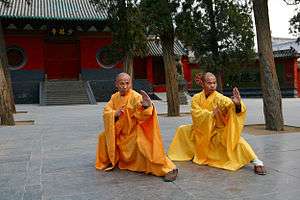Hung Hei-gun
| Hung Hei-gun | |
|---|---|
| Born |
1745 Hua County, Guangdong Province, Qing Empire |
| Died | 1825 (aged 79–80) |
| Style |
Chinese martial arts Black Tiger Fist |
| Occupation | Martial artist |
| Notable students |
Luk Ah-choi (陸亞采) Lei Jou-fun (李祖寬) |
| Hung Hei-gun | |||||||||
| Traditional Chinese | 洪熙官 | ||||||||
|---|---|---|---|---|---|---|---|---|---|
| Simplified Chinese | 洪熙官 | ||||||||
| |||||||||
| Part of a series on |
| Chinese martial arts (Wushu) |
|---|
 |
|
Styles of Chinese martial arts
|
| Wushu in the world |
|
Historical locations Chen Village (陳家溝) |
| Wushu athletes/practitioners |
|
Legendary figures Bodhidharma (菩提達摩) |
|
Historical individuals Yue Fei (岳飛; 1103—1142) |
|
Modern celebrities Bruce Lee (李小龍 1940—1973) |
| Wushu influence |
|
Related |
Hung Hei-gun or Hong Xiguan (1745—1825) was a Chinese martial artist who lived in the Qing dynasty. He was also an influential figure in the Southern Shaolin school of Chinese martial arts. His name is also alternatively romanised as Hung Hei-koon, Hung Hei-kwun, Hung Hsi-kuan, and similar renditions.
Life
Hung was originally a tea merchant. He escaped to the Southern Shaolin Monastery in Fujian Province after having an argument with Manchus elites. The abbot, Reverend Jee-sin, accepted him into the monastery and soon found out how talented and hardworking he was in Southern Shaolin martial arts. Jee-sin was impressed by these qualities and soon began to teach Hung the Black Tiger Fist that he specialised in. After six years, Hung became the best among the "lay" members of Southern Shaolin Monastery. These "lay" members refer to people who learnt Southern Shaolin martial arts but were not ordained as monks in the monastery. However, Qing government forces destroyed Southern Shaolin Monastery later because the monastery provided refuge for many rebels seeking to overthrow the Qing dynasty.
Students
Hung had two notable students: Luk Ah-choi (陸阿采; Lu A'cai) and Lei Jou-fan (李祖寬; Li Zukuan). Luk learnt Southern Shaolin martial arts from both Hung and Hung's master, Reverend Jee-sin. He founded the Hung Ga (洪家) style of martial arts, which he named after the Hung-mun (洪門), a Chinese fraternal organisation that was associated with the anti-Qing revolutionary movement. Lei founded the Hung Fut (洪佛) style of martial arts.
Cultural references
Donnie Yen portrayed Hung in the 1994 Hong Kong television series The Kung Fu Master, which was produced by ATV and based on legends about Hung and Fong Sai-yuk. Jet Li also portrayed Hung in the 1994 Hong Kong film The New Legend of Shaolin, which was loosely based on Hung's life and incorporated elements from the Japanese manga Lone Wolf and Cub.
See also
References
- Beginning Shaolin Hung-Gar Kung Fu - John Leong
- Hung Gar Kung Fu: Chinese art of self defense - Bucksam Kong and Eugene H. Ho, copyright 1973 Ohara Publications Inc.
- The Tiger/Crane Form of Hung Gar Kung Fu - Bucksam Kong, copyright 1983 Ohara Publications Inc.
- Kung Fu Magazine - Sept.1999, Pacific Rim publications, Arnaldo Ty Nunez